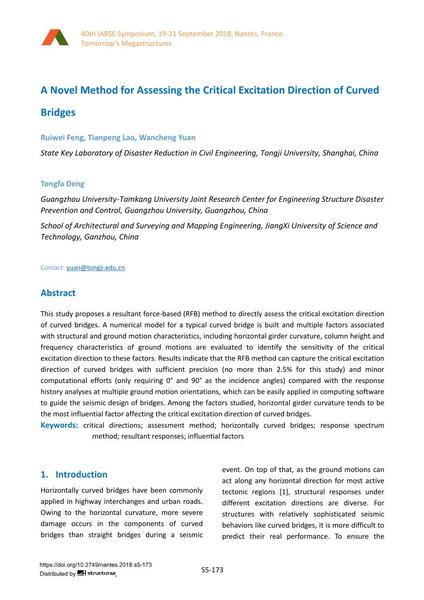A Novel Method for Assessing the Critical Excitation Direction of Curved Bridges

|
|
|||||||||||
Détails bibliographiques
| Auteur(s): |
Ruiwei Feng
(State Key Laboratory of Disaster Reduction in Civil Engineering, Tongji University, Shanghai, China)
Tianpeng Lao (State Key Laboratory of Disaster Reduction in Civil Engineering, Tongji University, Shanghai, China) Wancheng Yuan (State Key Laboratory of Disaster Reduction in Civil Engineering, Tongji University, Shanghai, China) Tongfa Deng (Guangzhou University-Tamkang University Joint Research Center for Engineering Structure Disaster Prevention and Control, Guangzhou University, Guangzhou, China) |
||||
|---|---|---|---|---|---|
| Médium: | papier de conférence | ||||
| Langue(s): | anglais | ||||
| Conférence: | IABSE Symposium: Tomorrow’s Megastructures, Nantes, France, 19-21 September 2018 | ||||
| Publié dans: | IABSE Symposium Nantes 2018 | ||||
|
|||||
| Page(s): | S5-173 | ||||
| Nombre total de pages (du PDF): | 9 | ||||
| DOI: | 10.2749/nantes.2018.s5-173 | ||||
| Abstrait: |
This study proposes a resultant force-based (RFB) method to directly assess the critical excitation direction of curved bridges. A numerical model for a typical curved bridge is built and multiple factors associated with structural and ground motion characteristics, including horizontal girder curvature, column height and frequency characteristics of ground motions are evaluated to identify the sensitivity of the critical excitation direction to these factors. Results indicate that the RFB method can capture the critical excitation direction of curved bridges with sufficient precision (no more than 2.5% for this study) and minor computational efforts (only requiring 0° and 90° as the incidence angles) compared with the response history analyses at multiple ground motion orientations, which can be easily applied in computing software to guide the seismic design of bridges. Among the factors studied, horizontal girder curvature tends to be the most influential factor affecting the critical excitation direction of curved bridges. |
||||
